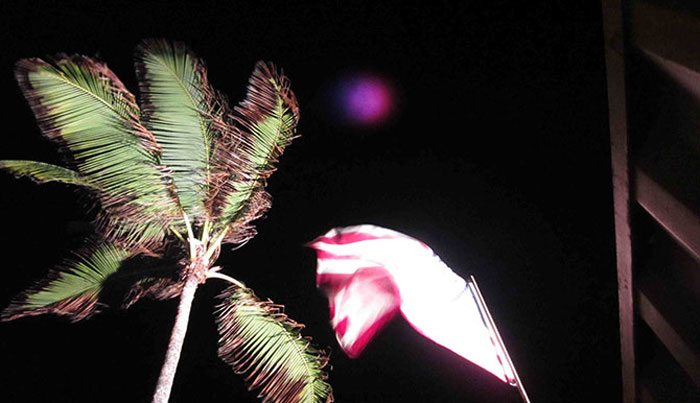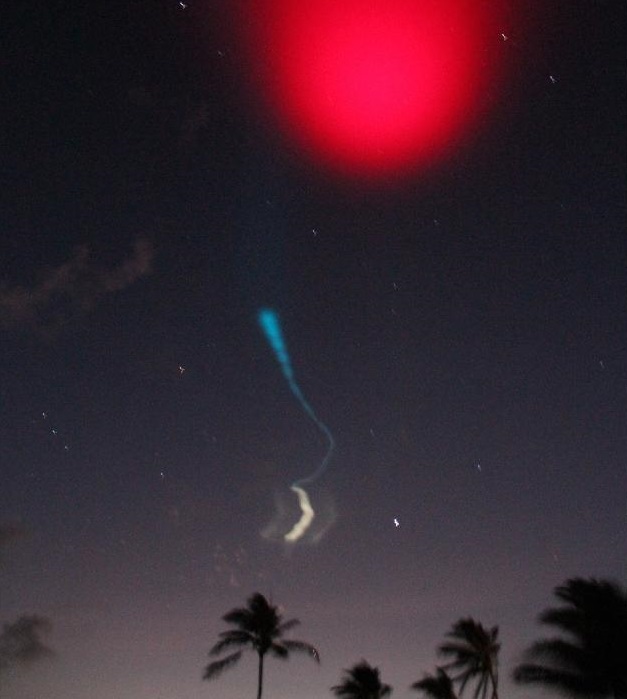.

The Metal Oxide Space Cloud Experiment (MOSC) released a Samarium vapor into the atmosphere minutes after its launch from the Marshall Islands creating a red cloud of charged particles in the ionosphere. Credit: NASA.
.
First of Four Sounding Rockets Launched from the Marshall Islands
A NASA sounding rocket supporting a study of ionosphere and its impact on radio transmissions was launched at 3:38 a.m. EDT, May 1 from Roi-Namur, Republic of the Marshall Islands. The Terrier-Orion rocket was the first of two to be launched as part of the Metal Oxide Space Cloud experiment (MOSC).
The rocket flew to approximately 115 miles altitude and the payload impacted safely in the Pacific Ocean about 20 minutes after launch. MOSC released a Samarium vapor creating a red cloud of charged particles in the ionosphere.
Researchers from the Air Force Research Laboratory studied the cloud as it dispersed and its impact on radio transmissions sent from multiple locations. MOSC is being launched with the assistance of the Department of Defense Space Test Program.
In addition to the two rockets for MOSC, NASA is launching two sounding rockets for the Equatorial Vortex Experiment (EVEX). EVEX will study space weather in the ionosphere, specifically the circulation of ionized gas, the intensity of which is believed related to post-sunset ionospheric storms that can impact satellite communication and navigation systems and signals.
As part of the mission, during the rocket flights red and white vapor clouds will form to allow the scientists to observe the winds in the upper atmosphere.
The launch window for both projects runs through May 12.
.
Quelle: NASA
.
Update: 9.05.2013
.

Sounding Rockets Launch from the Marshall Islands
Red and white vapor clouds filled the skies over the Marshall Islands as part of NASA’s Equatorial Vortex Experiment (EVEX). The red cloud was formed by the release of lithium vapor and the white tracer clouds were formed by the release of trimethyl aluminum (TMA). These clouds allowed scientists on the ground from various locations in the Marshall Islands to observe the neutral winds in the ionosphere.
The EVEX was successfully conducted during the early morning hours on May 7 from Roi Namur, Republic of the Marshall Islands. A NASA Terrier-Oriole sounding rocket was launched at 3:39 a.m. EDT and was followed by a launch of Terrier-Improved Malemute sounding rocket 90 seconds later. Preliminary indications are that both rockets released their vapor clouds of lithium or trimethyl aluminum, which were observed from various locations in the area, and all science instruments on the rockets worked as planned.
The EVEX was successfully conducted during the early morning hours on May 7 from Roi Namur, Republic of the Marshall Islands. A NASA Terrier-Oriole sounding rocket was launched at 3:39 a.m. EDT and was followed by a launch of Terrier-Improved Malemute sounding rocket 90 seconds later. Preliminary indications are that both rockets released their vapor clouds of lithium or trimethyl aluminum, which were observed from various locations in the area, and all science instruments on the rockets worked as planned.
Quelle: NASA
-
Red and white vapor clouds filled the skies over the Marshall Islands as part of NASA’s Equatorial Vortex Experiment (EVEX). The red cloud was formed by the release of lithium vapor and the white tracer clouds were formed by the release of trimethyl aluminum (TMA). These clouds allowed scientists on the ground from various locations in the Marshall Islands to observe the neutral winds in the ionosphere. The EVEX was successfully conducted during the early morning hours on May 7 from Roi Namur, Republic of the Marshall Islands. A NASA Terrier-Oriole sounding rocket was launched at 3:39 a.m. EDT and was followed by a launch of Terrier-Improved Malemute sounding rocket 90 seconds later. Preliminary indications are that both rockets released their vapor clouds of lithium or trimethyl aluminum, which were observed from various locations in the area, and all science instruments on the rockets worked as planned. Image Credit: NASA/John Grant
6603 Views
